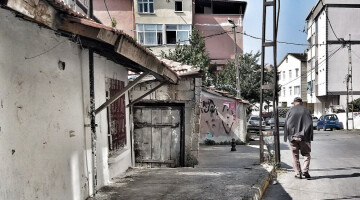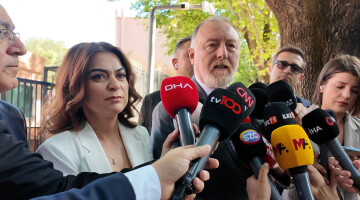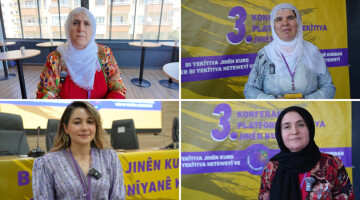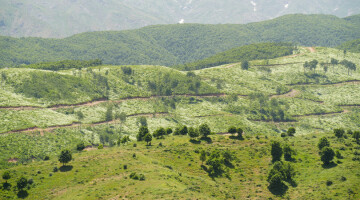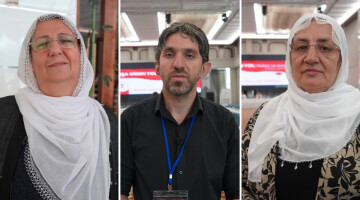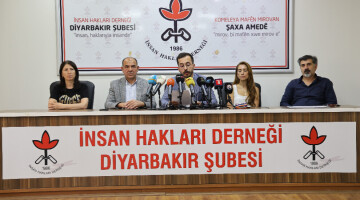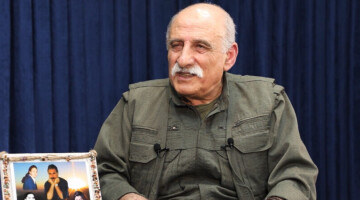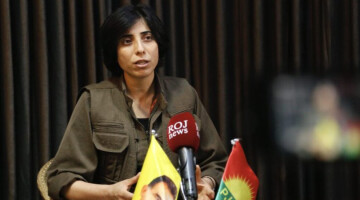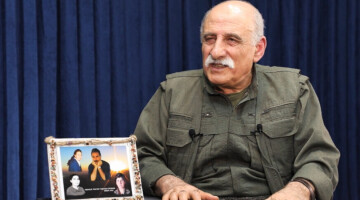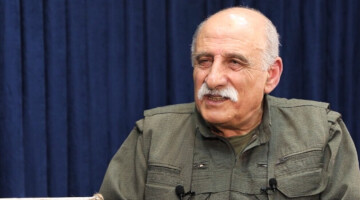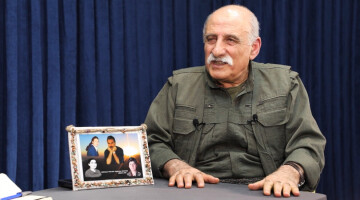“Everyone should come here and join the resistance. The truth is Kurdistan, not the lies of the fascist state,” he said as he crossed into Kobanê. He turned cannon shells into flowerpots and remnants of the resistance into a museum.
Comrade Karker (60), originally an Albanian, went to Rojava to join the YPG and protect Kobanê from ISIS occupation. Rıfat Horoz was the grandson of a guerrilla who had fought before the First World War. His grandfather came from an area inhabited by ethnic Albanians in Pristina, Kosovo, but after the First World War he was deported to Sinop, Turkey, as part of an ethnic cleansing campaign. Comrade Karker was born there and later moved to Zonguldak with his family. His father was a miner and trade unionist. He thus got to know strikes and rallies at an early age.
PARTICIPATION IN THE RIZGARI MOVEMENT
After his father’s death in a mining accident, he moved to Istanbul at the age of 13 to live with his aunt, who lived in a neighbourhood that was home to many revolutionary activities. Rifat soon met with the young revolutionaries there. He joined the Rizgari movement, a Marxist Kurdish organization that promoted the idea that the colonized Kurdish population in Turkey could only be liberated through a revolution led by the Kurdish proletariat. He attended the bloody May Day in 1977 with Ala Rizgari (Flag of Liberation), a small offshoot group of the Rizgari party. He was arrested in 1978 as part of the Turkish state's crackdown on the Rizgari movement and was jailed together with renowned sociologist İsmail Beşikçi in the same ward. Like many revolutionaries before him, Comrade Rifat used his detention as an opportunity to expand his knowledge and analysis. He said that: “Prison was a great academy for me.”
GETTING TO KNOW THE PKK
After his release from prison in 1991, he established a transport company in Antep city on the Mediterranean coast. However, he never stopped his revolutionary activities. After his time in prison, he remained in contact with Kurdish revolutionaries and got to know the Kurdistan Workers' Party (PKK). As he later stated: “There was criticism/self-criticism in other organizations, but there was a deadlock in their analysis. The essence of the Apoist movement was humanity.” He was often on the streets, participating in demonstrations, working with youth activists and distributing newspapers and the magazine Democratic Nation. He visited political prisoners frequently.
GIVING HIS HOME TO A FAMILY FROM ROJAVA AND LEAVING FOR KOBANÊ
When ISIS attacked Kobanê on September 14, 2014, Kurdish leader Abdullah Öcalan called on the people to defend Kobanê, saying: “If this massacre attempt (in Kobanê) succeeds, it will end the ongoing resolution process and prompt a new, long-term coup mechanism.” Comrade Karker responded immediately to Öcalan’s call. He gave his house in Sinop (North Turkey) to a Kurdish refugee family who had fled the war in Rojava. He immediately set out for Kobanê but failed to cross the border. He stayed in the village of Misyanter, close to the border, and kept guard day and night for weeks to prevent ISIS mercenaries and their supplies from crossing the border and joining the war on Kobanê. He was instantly loved by the people and his comrades for his honourable personality, dedication and revolutionary spirit. In an interview he gave in October 2014, he said: “Everyone should come here and join the resistance. I invite them to stand with the people of Kobanê. There is an area of resistance, and there is a lot to learn here. There is a lot for us to learn from the Kurdish people. If citizens brainwashed by the lies of the fascist state want to know the truth, they should come and see Kurdistan for themselves.”
RESISTANCE MUSEUM AND LIBRARY PROJECTS
He undertook many projects in Misyanter, repairing damaged and ruined buildings. He established the Arîn Mîrkan Resistance Museum (dedicated to the memory of the YPJ fighter who had sacrificed herself in the Battle of Mishtenur Hill in Kobanê) and the Kader Ortakaya Library (dedicated to the memory of one of his fellow border guards who was martyred while trying to cross into Kobanê). He described the projects in the following words: “There will be materials in the museum that will make you feel war and resistance, including gas canisters fired at the border line. We must fulfil our responsibility towards humanity in this village just across Kobanê. We felt the need to depict this war, resistance, history and drama to remember our comrades who were martyred heroically.”
Meanwhile, he was constantly looking for a way to cross into Kobanê. Finally, the YPG heard of his activities in the border area and helped him cross the border, after which, he soon began helping with the reconstruction of the city. He was now a member of the YPG and adopted the forename Heval Karker (Comrade Worker) and the surname Kobanê, which he loved so much. He decided to establish a war museum, and collected hundreds of unexploded bullets, mines and grenades, as well as other remnants and household items, in an attempt to draw attention to the stories of destruction and to make the city safer for civilians to return. He also transformed the shell casings into colourful flowerpots.”
TURNING CANNON SHELLS INTO FLOWERPOTS
Those who knew him describe Uncle Karker as follows: "What we will remember forever are his penetrating blue eyes and the immense kindness in his soul and heart. When we visited him in Kobanê, he was running a small workshop at Qada Azadi (Liberty Square). He was turning cannon shells into rainbow-colored flowerpots (he was known for the famous cannon bullets he turned into flowerpots in Kobanê). He was tall and lanky. When he invited us to his workshop, he was radiating enthusiasm, warmth and a childlike innocence. It was clear that he loved flowers and nature, as could be seen from his beautiful and lovely garden. That was the beauty of Kobanê, which brought the most wonderful, wild and gentle souls around the world to a small city blockaded by barbarism and inhumanity. The real flowers of Kobanê were the spirit born by him and others like him.”
'LET'S BUILD SOCIALISM AND POPULAR REVOLUTION'
While in Kobanê, Karker said: “I am a witness to this war right now. I am a part of it, and I am in it. I must be here to fight the forces that organize ISIS fascism against the system that has developed here around the paradigm introduced by our leader. A revolution is taking place here. For 40 years, we took to the streets and called for a socialist revolution. Now, we will build socialism here. Come and let's build socialism together. What kind of socialism you want, what kind of popular revolution you want, come here and let's build it together.”
HE FELL A MARTYR AND WENT DOWN IN HISTORY
Karker Kobanê was martyred following a major terrorist attack carried out by ISIS on the city on June 26, 2015. About 223 people lost their lives in this attack. The activities of Karker, who devoted his entire life to revolutionary practices, as well as the museums and libraries he established, continue to exist thanks to the lasting impression he left on everyone who met him.


